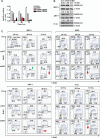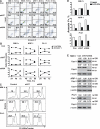MAGE-A inhibits apoptosis in proliferating myeloma cells through repression of Bax and maintenance of survivin
- PMID: 21565982
- PMCID: PMC3131419
- DOI: 10.1158/1078-0432.CCR-10-1820
MAGE-A inhibits apoptosis in proliferating myeloma cells through repression of Bax and maintenance of survivin
Abstract
Purpose: The type I Melanoma Antigen GEnes (MAGEs) are commonly expressed in cancers, fueling speculation that they may be therapeutic targets with oncogenic potential. They form complexes with RING domain proteins that have E3 ubiquitin ligase activity and promote p53 degradation. MAGE-A3 was detected in tumor specimens from patients with multiple myeloma and its expression correlated with higher frequencies of Ki-67(+) malignant cells. In this report, we examine the mechanistic role of MAGE-A in promoting survival of proliferating multiple myeloma cells.
Experimental design: The impact of MAGE-A3 expression on survival and proliferation in vivo was examined by immunohistochemical analysis in an independent set of tumor specimens segregated into two groups: newly diagnosed, untreated patients and patients who had relapsed after chemotherapy. The mechanisms of MAGE-A3 activity were investigated in vitro by silencing its expression by short hairpin RNA interference in myeloma cell lines and primary cells and assessing the resultant effects on proliferation and apoptosis.
Results: MAGE-A3 was detected in a significantly higher percentage of relapsed patients compared with newly diagnosed, establishing a novel correlation with progression of disease. Silencing of MAGE-A showed that it was dispensable for cell cycling, but was required for survival of proliferating myeloma cells. Loss of MAGE-A led to apoptosis mediated by p53-dependent activation of proapoptotic Bax expression and by reduction of survivin expression through both p53-dependent and -independent mechanisms.
Conclusions: These data support a role for MAGE-A in the pathogenesis and progression of multiple myeloma by inhibiting apoptosis in proliferating myeloma cells through two novel mechanisms.
Figures





Similar articles
-
Melanoma antigen genes (MAGE); novel functional targets in multiple myeloma.Semin Hematol. 2025 Feb;62(1):43-49. doi: 10.1053/j.seminhematol.2024.10.007. Epub 2024 Oct 28. Semin Hematol. 2025. PMID: 39580273 Review.
-
Cancer-testis antigens MAGE-C1/CT7 and MAGE-A3 promote the survival of multiple myeloma cells.Haematologica. 2010 May;95(5):785-93. doi: 10.3324/haematol.2009.014464. Epub 2009 Dec 16. Haematologica. 2010. PMID: 20015885 Free PMC article.
-
Melanoma associated antigen (MAGE)-A3 promotes cell proliferation and chemotherapeutic drug resistance in gastric cancer.Cell Oncol (Dordr). 2016 Apr;39(2):175-86. doi: 10.1007/s13402-015-0261-5. Epub 2016 Feb 11. Cell Oncol (Dordr). 2016. PMID: 26868260
-
RITA (Reactivating p53 and Inducing Tumor Apoptosis) is efficient against TP53abnormal myeloma cells independently of the p53 pathway.BMC Cancer. 2014 Jun 14;14:437. doi: 10.1186/1471-2407-14-437. BMC Cancer. 2014. PMID: 24927749 Free PMC article.
-
Emerging roles of the MAGE protein family in stress response pathways.J Biol Chem. 2020 Nov 20;295(47):16121-16155. doi: 10.1074/jbc.REV120.008029. Epub 2020 Sep 13. J Biol Chem. 2020. PMID: 32921631 Free PMC article. Review.
Cited by
-
NEDD8 Inhibition Overcomes CKS1B-Induced Drug Resistance by Upregulation of p21 in Multiple Myeloma.Clin Cancer Res. 2015 Dec 15;21(24):5532-42. doi: 10.1158/1078-0432.CCR-15-0254. Epub 2015 Jul 8. Clin Cancer Res. 2015. PMID: 26156395 Free PMC article.
-
TCR-Engineered T Cells Meet New Challenges to Treat Solid Tumors: Choice of Antigen, T Cell Fitness, and Sensitization of Tumor Milieu.Front Immunol. 2013 Nov 8;4:363. doi: 10.3389/fimmu.2013.00363. eCollection 2013. Front Immunol. 2013. PMID: 24265631 Free PMC article. Review.
-
A ballsy search for cancer targets.Nat Med. 2011 Aug 4;17(8):916-8. doi: 10.1038/nm0811-916. Nat Med. 2011. PMID: 21818078 No abstract available.
-
hMAGEA2 promotes progression of breast cancer by regulating Akt and Erk1/2 pathways.Oncotarget. 2017 Jun 6;8(23):37115-37127. doi: 10.18632/oncotarget.16184. Oncotarget. 2017. PMID: 28415749 Free PMC article.
-
Melanoma Antigen Family A (MAGE A) as Promising Biomarkers and Therapeutic Targets in Bladder Cancer.Cancers (Basel). 2024 Jan 5;16(2):246. doi: 10.3390/cancers16020246. Cancers (Basel). 2024. PMID: 38254738 Free PMC article. Review.
References
-
- Simpson AJ, Caballero OL, Jungbluth A, Chen YT, Old LJ. Cancer/testis antigens, gametogenesis and cancer. Nat Rev Cancer. 2005;5:615–25. - PubMed
-
- Scanlan MJ, Gure AO, Jungbluth AA, Old LJ, Chen YT. Cancer/testis antigens: an expanding family of targets for cancer immunotherapy. Immunol Rev. 2002;188:22–32. - PubMed
-
- Jungbluth AA, Ely S, DiLiberto M, et al. The cancer-testis antigens CT7 (MAGE-C1) and MAGE-A3/6 are commonly expressed in multiple myeloma and correlate with plasma-cell proliferation. Blood. 2005;106:167–74. - PubMed
Publication types
MeSH terms
Substances
Grants and funding
LinkOut - more resources
Full Text Sources
Medical
Research Materials
Miscellaneous

